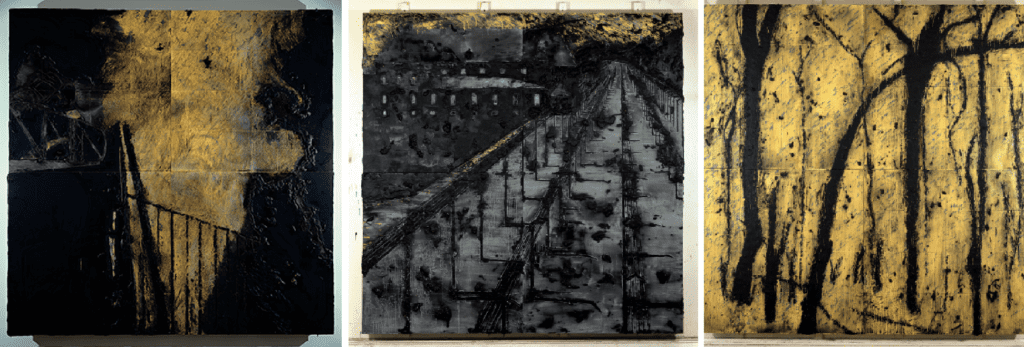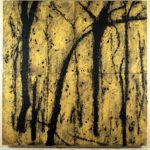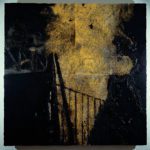Donald Sultan’s “Disaster Paintings” at SAAM
By • July 26, 2017 0 1097

In the 1980s, the painter Donald Sultan began a series of industrial landscapes that he called “Disaster Paintings,” transforming images from newspapers into large-scale, heavily wrought monuments to industrial devastation and environmental catastrophe. News photos of forest fires and freight-train derailments became vague yet hauntingly recognizable memorials to the daily currents of our history.
Sultan worked with these subjects for nearly a decade. Together, the “Disaster Paintings” illustrate robust, man-made structures as fragile constructs that can be undone by catastrophic events.
At the Smithsonian American Art Museum through Sept. 4, “Donald Sultan: The Disaster Paintings” is the first exhibition to focus on this series, the kind of ambitious, focused and far-reaching single body of work that few artists manage to achieve in a lifetime. The show includes 12 signature paintings from 1984 to 1990, including “Plant May 29 1985” from the Hirshhorn Museum. It is a unique lens through which to view an uncharacteristically long-term aesthetic focus on something as transient as daily news, a deeper look at a fleeting but substantial part of our lives.
“The series speaks to the impermanence of all things. The largest cities, the biggest structures, the most powerful empires — everything dies. Man is inherently self-destructive, and whatever is built will eventually be destroyed. That’s what the works talk about: life and death.”
– Donald Sultan
Born in 1951, Sultan’s career began with his first solo exhibition in 1977 in New York City, when he was just 26 years old. He rose to prominence in the 1980s. A painter, sculptor and printmaker, Sultan is highly regarded for his ongoing series of large-scale still-life paintings featuring structural renderings of fruit, flowers and other everyday objects, often abstracted and set against a rich, black background.
While Sultan’s still lifes depict and strengthen fragile and ephemeral objects, the “Disaster Paintings” focus on the industrial grandeur — and sometimes terror — of our surroundings, which exhibit a level of fragility in their propensity to be unhinged by nature. Although the series was completed before the 21st century, haunting reverberations of recent events such as the Fukushima power-plant disaster, Hurricane Katrina and the earthquakes in Haiti and Tibet can all be felt throughout the galleries.
Distinguished for combining such subject matter with industrial materials, such as tar, linoleum and Masonite tiles, the “Disaster Paintings” exemplify in both media and concept the vulnerability of the most progressive manufactured elements of modern culture. Demonstrating great physicality, Sultan’s series comprises a confluence of seeming dichotomies,
merging the industrial materials of Minimalism with representational painting, stylistically combining figuration with abstraction and making references to high and low culture, ranging from topical events to art historical iconography.
Featuring a wide array of disasters as subject matter — forest fires, railway accidents, arson, factories producing toxic plumes — the “Disaster Paintings” eternalize the real-life modern events we are faced with daily in contemporary society, yet quickly forget when the next catastrophe occurs. It is a timely moment in history for the “Disaster Paintings” to be reconsidered.
Sultan says that the key to his process is to use the heaviest materials he could find to make air. This is a wonderfully simple description of his paintings’ central irony. In this sense, the paintings rope together ideas of progress and decay, the future and the past. They are at once very specific renderings of individual traumas and generalized representations of dread, a combination that allows the paintings to reach well beyond the time they were made and resonate strongly today.
“The series speaks to the impermanence of all things. The largest cities, the biggest structures, the most powerful empires — everything dies. Man is inherently self-destructive, and whatever is built will eventually be destroyed,” Sultan says. “That’s what the works talk about: life and death.”
This is not the most uplifting exhibition one will see this summer, but it is certainly among the most directly and aggressively in dialogue with our world, our time, our place, our politics and our inherent cultural and moral conflicts in the 21st century.
- “Yellowstone Aug 15 1990,” 1990. Private collection, New York. © Donald Sultan
- “South End Feb 24 1986,” 1986. Dallas Museum of Art, Foundation for the Arts Collection, anonymous gift. © Donald Sultan
- “Polish Landscape II Jan 5 1990 (Auschwitz),” 1990. Parrish Art Museum, gift of the Broad Art Foundation. © Donald Sultan




